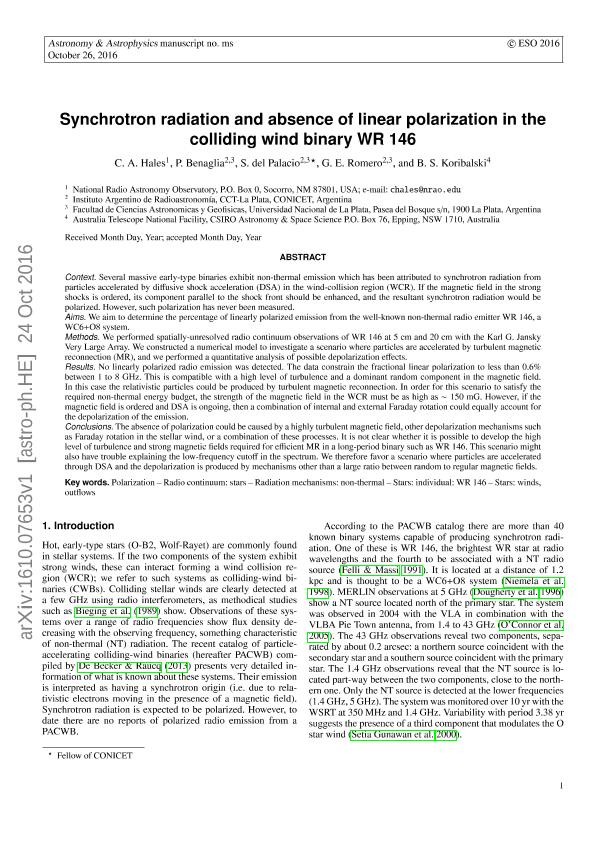Mostrar el registro sencillo del ítem
dc.contributor.author
Hales, C. A.
dc.contributor.author
Benaglia, Paula

dc.contributor.author
del Palacio, Santiago

dc.contributor.author
Romero, Gustavo Esteban

dc.contributor.author
Koribalski, Bärbel Silvia
dc.date.available
2017-11-30T14:47:32Z
dc.date.issued
2017-02
dc.identifier.citation
Hales, C. A.; Benaglia, Paula; del Palacio, Santiago; Romero, Gustavo Esteban; Koribalski, Bärbel Silvia; Synchrotron radiation and absence of linear polarization in the colliding wind binary WR 146; EDP Sciences; Astronomy and Astrophysics; 598; 2-2017
dc.identifier.issn
0004-6361
dc.identifier.uri
http://hdl.handle.net/11336/29322
dc.description.abstract
Context. Several massive early-type binaries exhibit non-thermal emission which has been attributed to synchrotron radiation from particles accelerated by diffusive shock acceleration (DSA) in the wind-collision region (WCR). If the magnetic field in the strong shocks is ordered, its component parallel to the shock front should be enhanced, and the resultant synchrotron radiation would be polarized. However, such polarization has never been measured. Aims. We aim to determine the percentage of linearly polarized emission from the well-known non-thermal radio emitter WR 146, a WC6+O8 system. Methods. We performed spatially-unresolved radio continuum observations of WR 146 at 5 cm and 20 cm with the Karl G. Jansky Very Large Array. We constructed a numerical model to investigate a scenario where particles are accelerated by turbulent magnetic reconnection (MR), and we performed a quantitative analysis of possible depolarization effects. Results. No linearly polarized radio emission was detected. The data constrain the fractional linear polarization to less than 0.6% between 1 to 8 GHz. This is compatible with a high level of turbulence and a dominant random component in the magnetic field. In this case the relativistic particles could be produced by turbulent magnetic reconnection. In order for this scenario to satisfy the required non-thermal energy budget, the strength of the magnetic field in the WCR must be as high as ∼ 150 mG. However, if the magnetic field is ordered and DSA is ongoing, then a combination of internal and external Faraday rotation could equally account for the depolarization of the emission. Conclusions. The absence of polarization could be caused by a highly turbulent magnetic field, other depolarization mechanisms such as Faraday rotation in the stellar wind, or a combination of these processes. It is not clear whether it is possible to develop the high level of turbulence and strong magnetic fields required for efficient MR in a long-period binary such as WR 146. This scenario might also have trouble explaining the low-frequency cutoff in the spectrum. We therefore favor a scenario where particles are accelerated through DSA and the depolarization is produced by mechanisms other than a large ratio between random to regular magnetic fields.
dc.format
application/pdf
dc.language.iso
eng
dc.publisher
EDP Sciences

dc.rights
info:eu-repo/semantics/openAccess
dc.rights.uri
https://creativecommons.org/licenses/by-nc-sa/2.5/ar/
dc.subject
Polarization
dc.subject
Radio Continuum
dc.subject
Radiation Mechanisms
dc.subject
Non Thermal Mechanisms
dc.subject
Wr 146 (Estrella)
dc.subject
Winds
dc.subject
Outflows
dc.subject.classification
Astronomía

dc.subject.classification
Ciencias Físicas

dc.subject.classification
CIENCIAS NATURALES Y EXACTAS

dc.title
Synchrotron radiation and absence of linear polarization in the colliding wind binary WR 146
dc.type
info:eu-repo/semantics/article
dc.type
info:ar-repo/semantics/artículo
dc.type
info:eu-repo/semantics/publishedVersion
dc.date.updated
2017-10-04T14:55:56Z
dc.journal.volume
598
dc.journal.pais
Francia

dc.description.fil
Fil: Hales, C. A.. National Radio Astronomy Observatory; Estados Unidos
dc.description.fil
Fil: Benaglia, Paula. Universidad Nacional de La Plata; Argentina. Provincia de Buenos Aires. Gobernación. Comisión de Investigaciones Científicas. Instituto Argentino de Radioastronomía. Consejo Nacional de Investigaciones Científicas y Técnicas. Centro Científico Tecnológico Conicet - La Plata. Instituto Argentino de Radioastronomía; Argentina
dc.description.fil
Fil: del Palacio, Santiago. Provincia de Buenos Aires. Gobernación. Comisión de Investigaciones Científicas. Instituto Argentino de Radioastronomía. Consejo Nacional de Investigaciones Científicas y Técnicas. Centro Científico Tecnológico Conicet - La Plata. Instituto Argentino de Radioastronomía; Argentina
dc.description.fil
Fil: Romero, Gustavo Esteban. Universidad Nacional de La Plata; Argentina. Provincia de Buenos Aires. Gobernación. Comisión de Investigaciones Científicas. Instituto Argentino de Radioastronomía. Consejo Nacional de Investigaciones Científicas y Técnicas. Centro Científico Tecnológico Conicet - La Plata. Instituto Argentino de Radioastronomía; Argentina
dc.description.fil
Fil: Koribalski, Bärbel Silvia. Australia Telescope National Facility; Australia
dc.journal.title
Astronomy and Astrophysics

dc.relation.alternativeid
info:eu-repo/semantics/altIdentifier/doi/http://dx.doi.org/10.1051/0004-6361/201629644
dc.relation.alternativeid
info:eu-repo/semantics/altIdentifier/url/https://www.aanda.org/articles/aa/abs/2017/02/aa29644-16/aa29644-16.html
Archivos asociados
